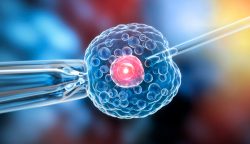 Researchers from The Univ. of Melbourne and the Australian Nat’l Univ. have made a major breakthrough that could revolutionize stem cell delivery. They’ve created a novel ‘hybrid’ hydrogel, which enables clinicians to transport healthy amounts of stem cells directly into the site of brain injuries in mice. This overcomes one of the biggest challenges surrounding this technology since its inception over thirty years ago.
Researchers from The Univ. of Melbourne and the Australian Nat’l Univ. have made a major breakthrough that could revolutionize stem cell delivery. They’ve created a novel ‘hybrid’ hydrogel, which enables clinicians to transport healthy amounts of stem cells directly into the site of brain injuries in mice. This overcomes one of the biggest challenges surrounding this technology since its inception over thirty years ago.
The potential for hydrogel is immense. This water-based gel can not only transport substances into the body, but also provides a nourishing environment that helps stem cells to thrive. It has the ability to deliver oxygen and supply vital nutrients to promote healthy growth. After a stroke or other injury, the brain can suffer from damage to its blood system. To allow cells in that area of the brain to survive until it is repaired, this innovative hydrogel has been developed as an artificial supply of much needed oxygen and nutrients. This has hope for scientists that it will help enhance current treatments involving stem cell therapy and aid in restoring damaged tissues across many areas of medicine.
After five years of intensive study, the team found a breakthrough to ensure stem cells remain viable during delivery. This progress was made possible by utilizing a synthetic protein based on myoglobin from whales and horses. Myoglobin is an oxygen-storing compound commonly found in deep water mammals for extended dives, and galloping equines needing sustainable energy levels over long distances.
This study has achieved incredible progress in healing injured brain tissue. The encouraging results suggest that new, healthy tissue can be created for future therapies. It was discovered that by infusing the delivery hydrogel with myoglobin and oxygen supply, stem cells survive longer and are able to mimic natural responses of regular functioning brain matter. This opens up exciting doors into furthering our understanding of regenerative science.
Researchers and clinicians around the world are brimming with excitement over this recent breakthrough. It has been successfully demonstrated within mice brains, but experts believe it can be generalized to have a broad range of applications. This could be from cell transplantation to drug delivery and even offering 3D versions of diseases in vitro.
No longer bound by traditional limitations, this proof-of-concept discovery offers hope that clinicians may soon have an effective tool to aid the regeneration process. This could pave the way for revolutionary medical treatments using injectable nanomaterials – ushering us into an exciting new era of healthcare.
To view the original scientific study click below:
Hydrogel oxygen reservoirs increase functional integration of neural stem cell grafts by meeting metabolic demands





